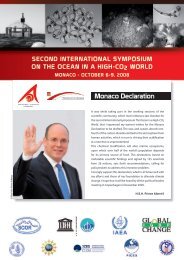Oceans of noise - Whale and Dolphin Conservation Society
Oceans of noise - Whale and Dolphin Conservation Society
Oceans of noise - Whale and Dolphin Conservation Society
- No tags were found...
Create successful ePaper yourself
Turn your PDF publications into a flip-book with our unique Google optimized e-Paper software.
levels exceed the ear’s tolerance, i.e. auditory damage results from metabolic exhaustion or overextension<strong>of</strong> one <strong>of</strong> the ear’s components. Sub-lethal, <strong>noise</strong>-induced trauma is possible as a result<strong>of</strong> high levels <strong>of</strong> shipping <strong>noise</strong>, for instance. Sub-lethal impacts can lead indirectly to death incetaceans as they render animals unable to detect prey or predators <strong>and</strong> also make them unable toorientate <strong>and</strong> avoid shipping traffic or obstacles.Ketten (1995) divides acoustic trauma resulting from intense <strong>noise</strong> levels into three categories:1) Mild (recovery possible), e.g. pain, vertigo, tinnitus, hearing loss, tympanic tears.2) Moderate (partial hearing loss), e.g. otis media, tympanic membrane haematoma, serum orblood in the inner ear, dissection <strong>of</strong> the mucosa.3) Severe (permanent hearing loss <strong>and</strong> damage), e.g. ossicular fracture or dislocation, round/ovalwindow rupture, CSF leakage into the inner ear, cochlear <strong>and</strong> saccular damage.Sound at any level can cause hearing damage by decreasing auditory sensitivity. One <strong>of</strong> the mostcommon mild traumatic effects is a threshold shift. The auditory threshold <strong>of</strong> a sound is theminimum level <strong>of</strong> intensity at which a sound can be heard. After this level <strong>of</strong> auditory trauma, thethreshold becomes higher <strong>and</strong> hearing sounds becomes more difficult. Threshold shifts may betemporary (TTS), or can be permanent with greater intensities <strong>of</strong> <strong>noise</strong>. Multiple or longer periods<strong>of</strong> exposure to <strong>noise</strong> levels causing TTS can also cause permanent threshold shifts (PTS). Thesethreshold shifts are caused by hair cell fatigue, hair cell damage or nerve degeneration.Submerged humans exposed to underwater source sounds at intensities <strong>of</strong> 150-180 dB (re 1 µPa;0.7-5.6 kHz) suffered TTS. This could be used as a rough guideline for sound intensities thatcould cause TTS in cetaceans, though the greater sensitivity <strong>of</strong> the cetacean ear <strong>and</strong> the moreefficient coupling <strong>of</strong> sound with the cetacean body may require a more conservative view.It has been suggested that some hearing impairment has led to the deaths <strong>of</strong> sperm <strong>and</strong> humpbackwhales in industrial areas as they are unable to detect potential threats e.g. boat traffic <strong>and</strong> fishinggear (Lien et al. 1993; Andre in Moscrop 1997).Significant, physiological impacts repeatedly go undetected, as we don’t have the ability to detect<strong>and</strong> assess them. Even carcasses are very rarely encountered at sea, as they sink relativelyquickly. There is no way to quantify such impacts.5.3.4. Underst<strong>and</strong>ing <strong>of</strong> biological significanceThe impact <strong>of</strong> <strong>noise</strong> pollution on non-migrating animals or animals engaged in a more localisedactivity such as calving or feeding is probably most significant over the longer term. For example,continual displacement from these areas by sustained <strong>noise</strong> pollution could have a much morepr<strong>of</strong>ound <strong>and</strong> serious effect on individual animals at a population level.Consequences will not become apparent until more research is conducted into the long-termeffects <strong>of</strong> <strong>noise</strong> pollution. This is difficult in areas where minimal information about cetace<strong>and</strong>istribution is available.58




